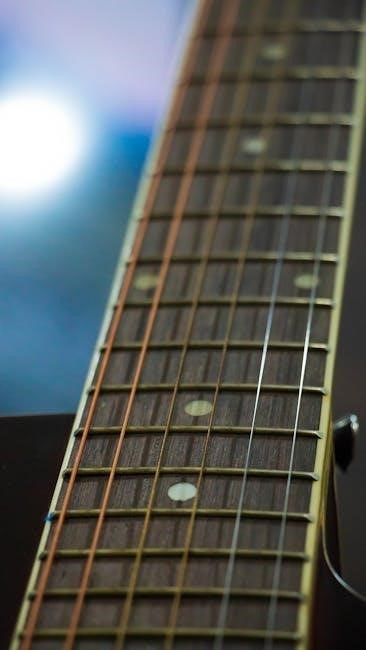Jazz guitar unlocks a world of harmonic richness‚ and mastering jazz chords is key․ A fantastic resource‚ like the Fachords․com
ebook
(https://www․fachords․com/static/download/ebooks/fachords-chords-ebook․pdf)‚
provides comprehensive chord diagrams‚
note names‚ and intervals – a truly amazing find!
What is Jazz Guitar and Why Learn These Chords?
Jazz guitar represents a captivating evolution of guitar playing‚ moving beyond simple accompaniment to embrace complex harmonies and improvisational freedom․ It’s a style deeply rooted in the rich history of jazz music‚ a genre born in the early 20th century and flourishing throughout the Jazz Age‚ as famously coined by F․ Scott Fitzgerald․ This era saw the rise of iconic vocalists like Bessie Smith‚ whose recordings featured collaborations with pioneering jazz musicians․
Learning jazz chords isn’t merely about memorizing shapes; it’s about understanding the underlying harmonic language․ Resources like the downloadable ebook from Fachords․com (https://www․fachords․com/static/download/ebooks/fachords-chords-ebook․pdf) are invaluable‚ offering a unique combination of finger positions‚ note names‚ and crucial interval information․ This detailed approach allows for a deeper comprehension of chord construction and facilitates more informed improvisation․
Furthermore‚ exploring the styles of influential jazz guitarists like Art Pepper and the groundbreaking Ornette Coleman reveals diverse approaches to harmony․ Coleman’s “Free Jazz” represents a radical departure from traditional structures‚ while Pepper’s work exemplifies the beauty of West Coast jazz․ Mastering these chords unlocks the ability to navigate this diverse landscape and express your own musical voice․
The Importance of Chord Voicings in Jazz
In jazz‚ simply knowing a chord isn’t enough; the voicing – the specific arrangement of notes within the chord – is paramount․ Different voicings create vastly different textures and colors‚ influencing the overall harmonic landscape․ A well-chosen voicing can add sophistication‚ tension‚ or release‚ shaping the emotional impact of the music․
The detailed chord charts available‚ such as the comprehensive PDF from Fachords․com (https://www․fachords․com/static/download/ebooks/fachords-chords-ebook․pdf)‚ highlight this importance by displaying not only finger positions but also the individual notes and intervals․ This allows guitarists to visualize and understand the harmonic implications of each voicing․
Understanding voicings is crucial for navigating the complex harmonies found in the music of artists like Art Pepper and Ornette Coleman․ While Coleman pushed boundaries with “Free Jazz‚” even within that context‚ careful voicing choices contribute to the overall sonic effect․ Similarly‚ exploring the work of Bessie Smith and her accompanying musicians reveals how thoughtful voicings supported her powerful vocals during the Jazz Age․ Ultimately‚ mastering voicings empowers guitarists to move beyond rote memorization and engage with jazz harmony on a deeper level․

Basic Jazz Chord Shapes
Jazz chord foundations begin with Major 7th‚ Minor 7th‚ and Dominant 7th shapes․ The Fachords․com PDF (https://www․fachords․com/static/download/ebooks/fachords-chords-ebook․pdf)
clearly illustrates these essential forms․
Major 7th Chords
Major 7th chords introduce a sophisticated color to your jazz playing‚ adding a lush and refined quality․ These chords are built with a root‚ major third‚ perfect fifth‚ and a major seventh interval․ Understanding their construction is crucial for both playing and improvisation․
The Fachords․com ebook (https://www․fachords․com/static/download/ebooks/fachords-chords-ebook․pdf) is an invaluable resource for visualizing these shapes․ It uniquely presents chord diagrams alongside finger positions‚ note names‚ and crucial interval information – a feature often missing from standard guitar chord charts․ This allows for a deeper understanding of the chord’s harmonic structure․
Beginners often find the inclusion of intervals particularly helpful‚ as it connects the visual shape on the fretboard to the underlying music theory; Experiment with different voicings of Major 7th chords to discover the subtle nuances in their sound․ The PDF’s clarity and comprehensive approach make learning these essential jazz chords significantly easier․ Mastering these shapes will unlock a wealth of harmonic possibilities in your jazz guitar journey․
Minor 7th Chords
Minor 7th chords are foundational in jazz harmony‚ providing a melancholic yet sophisticated sound․ Constructed with a root‚ minor third‚ perfect fifth‚ and minor seventh interval‚ they create a distinctly different mood compared to major 7th chords․ These are essential for navigating jazz progressions and creating expressive melodies․
The Fachords․com ebook (https://www․fachords․com/static/download/ebooks/fachords-chords-ebook․pdf) proves exceptionally useful for learning these shapes․ Its unique presentation of chord diagrams‚ coupled with finger positions‚ note names‚ and interval details‚ offers a comprehensive learning experience․ Many users praise this feature‚ noting the clarity it brings to understanding chord construction․
The PDF’s detailed approach helps connect the visual representation on the fretboard to the underlying theory․ Practicing various voicings of Minor 7th chords will reveal their versatility and expressive potential․ This resource is truly amazing‚ offering a clear and helpful path to mastering these vital jazz guitar building blocks․ It’s a fantastic tool for both beginners and experienced players․
Dominant 7th Chords
Dominant 7th chords are the workhorses of jazz‚ creating tension and driving harmonic movement․ Built with a root‚ major third‚ perfect fifth‚ and minor seventh‚ they possess a characteristic “bluesy” quality and strongly resolve to the tonic․ Understanding these chords is crucial for comping‚ soloing‚ and analyzing jazz standards․
The Fachords․com ebook (https://www․fachords․com/static/download/ebooks/fachords-chords-ebook․pdf) is an invaluable resource for mastering dominant 7th chords․ Its detailed diagrams‚ showing finger positions alongside note names and intervals‚ provide a clear visual and theoretical understanding․ Users consistently highlight the ebook’s usefulness and clarity․
The PDF’s comprehensive approach allows you to connect the shapes on the fretboard with the underlying musical theory․ Exploring different voicings of dominant 7th chords unlocks a wide range of harmonic possibilities․ This resource is truly amazing‚ offering a practical and insightful guide to these essential jazz guitar chords; It’s a fantastic tool for building a solid harmonic foundation․

Advanced Jazz Chord Concepts
Jazz harmony expands beyond basic chords with 9th‚ 13th‚ and altered dominant voicings․ The Fachords․com PDF unlocks these complexities‚
providing
detailed diagrams for advanced guitar chord study․
9th Chords and Their Applications
9th chords introduce a beautiful‚ sophisticated color to jazz guitar playing‚ adding a layer of harmonic interest beyond the standard 7th chords․ These chords are formed by adding the 9th interval to a 7th chord‚ creating a richer‚ more complex sound․ The Fachords․com ebook (https://www․fachords․com/static/download/ebooks/fachords-chords-ebook․pdf) is an invaluable resource for visualizing and learning these shapes‚ clearly displaying finger positions‚ note names‚ and crucial intervals simultaneously․
Understanding the applications of 9th chords is vital․ They frequently function as dominant chords resolving to the tonic‚ creating a strong pull and a lush harmonic movement․ They can also be used as major or minor chords‚ adding a subtle tension and release․ The PDF’s detailed diagrams allow guitarists to quickly grasp various voicings‚ enabling them to seamlessly incorporate 9th chords into improvisations and comping․
Experimenting with different 9th chord voicings – such as those utilizing drop 2 or shell voicings – will unlock a wider palette of sounds․ The ebook’s comprehensive approach ensures a solid foundation for mastering these essential jazz harmonies on the guitar․
13th Chords: Adding Complexity
13th chords represent a further step in harmonic sophistication for the jazz guitarist‚ building upon 9th chords by adding the 13th interval․ This creates an even more complex and colorful sound‚ often used to create a sense of lushness and harmonic ambiguity․ The Fachords․com ebook (https://www․fachords․com/static/download/ebooks/fachords-chords-ebook․pdf) proves exceptionally helpful in deciphering these voicings‚ presenting clear diagrams with finger positions‚ note names‚ and interval information․

These chords are frequently employed as dominant chords leading to resolution‚ or as extensions of major or minor chords‚ adding a subtle‚ yet noticeable‚ harmonic depth․ Mastering 13th chords requires a strong understanding of chord construction and voicing principles․ The PDF’s detailed visual aids facilitate this learning process‚ allowing guitarists to quickly internalize the shapes and their corresponding sounds․
Exploring different voicings‚ and combining 13th chords with techniques like drop 2 or shell voicings‚ unlocks a vast range of harmonic possibilities․ This resource empowers players to confidently navigate complex jazz harmonies on the guitar․
Altered Dominant Chords (7b9‚ 7#9‚ 7alt)
Altered dominant chords – 7b9‚ 7#9‚ and 7alt – inject tension and chromaticism into jazz guitar playing‚ serving as powerful tools for creating dramatic harmonic movement․ These chords‚ often used as V7 chords resolving to Imaj7‚ introduce dissonance that demands resolution‚ adding a sophisticated edge to progressions․ The Fachords․com ebook (https://www․fachords․com/static/download/ebooks/fachords-chords-ebook․pdf) is invaluable for visualizing these complex voicings․
The “alt” designation signifies a chord containing a combination of altered extensions – b9‚ #9‚ #11‚ and b13 – offering a wide palette of harmonic colors․ Understanding the function of each alteration is crucial for effective improvisation and comping․ The PDF’s inclusion of note names and intervals alongside finger positions demystifies these often-intimidating chords․
Mastering these altered dominant voicings expands a guitarist’s harmonic vocabulary‚ enabling them to navigate the sophisticated harmonic landscape of jazz with confidence and creativity․ This resource provides a solid foundation for exploring advanced harmonic concepts․

Chord Voicings & Techniques
Chord voicings‚ like Drop 2 and Shell voicings‚ are essential jazz guitar techniques․ The Fachords․com PDF provides clear diagrams‚
helping you explore these concepts and
apply chord formulas effectively․
Drop 2 Voicings Explained
Drop 2 voicings are a cornerstone of jazz guitar harmony‚ offering a sophisticated and elegant sound․ They involve taking the second highest note of a chord and dropping it down an octave․ This creates closer voice leading and a more compact chord shape‚ ideal for navigating complex jazz progressions․
The Fachords․com PDF resource is incredibly valuable here‚ visually demonstrating how to construct Drop 2 voicings for various chord types – major 7th‚ minor 7th‚ dominant 7th‚ and beyond․ The inclusion of both finger positions‚ note names‚ and intervals simultaneously is a game-changer for understanding the underlying theory․
Instead of simply memorizing shapes‚ you can see why the voicing works‚ fostering a deeper connection to the harmony․ This allows for greater flexibility and improvisation․ Learning these voicings isn’t a “crutch‚” but a powerful tool for expanding your harmonic vocabulary and creating richer‚ more nuanced jazz guitar playing․ The PDF’s clear presentation makes this technique accessible to players of all levels‚ from beginners to seasoned professionals․
Experiment with different Drop 2 voicings across the neck to discover the unique colors and textures they offer․
Shell Voicings for a Minimalist Approach
Shell voicings represent a beautifully minimalist approach to jazz guitar harmony․ They focus on the essential chord tones – typically the root‚ third‚ and seventh – omitting unnecessary notes to create a lighter‚ more transparent sound․ This technique is particularly useful in ensemble settings where you want to avoid cluttering the harmonic landscape․
The Fachords․com PDF excels in illustrating shell voicings‚ providing clear diagrams that highlight these core chord tones․ The simultaneous display of finger positions‚ note names‚ and intervals is invaluable for understanding the construction of these voicings and how they relate to the underlying chord theory․
These voicings aren’t about simplification at the expense of musicality; they’re about focusing on the essential elements and allowing space for other instruments to breathe․ They’re also fantastic for comping and creating a subtle harmonic foundation․ The PDF’s detailed presentation makes learning and applying shell voicings incredibly straightforward‚ even for those new to jazz harmony․
Mastering shell voicings unlocks a world of harmonic possibilities with a surprisingly small number of notes․
Using Chord Formulas for Improvisation
Understanding chord formulas is paramount for effective jazz improvisation on guitar․ Rather than memorizing countless chord shapes‚ learning the underlying formulas – like root‚ 3rd‚ 5th‚ 7th‚ 9th‚ 13th – empowers you to build chords and navigate harmonic changes with greater fluency and creativity․
The Fachords․com PDF is exceptionally helpful in this regard․ By displaying intervals alongside finger positions and note names‚ it visually reinforces the chord formulas․ This allows you to internalize the relationships between notes within a chord and apply that knowledge across the fretboard․
Once you grasp these formulas‚ you can begin to create your own chord voicings‚ alter existing ones‚ and seamlessly connect chords during improvisation․ This approach moves beyond rote memorization and fosters a deeper understanding of jazz harmony․
The PDF’s clear presentation transforms abstract theory into a practical tool for spontaneous musical expression‚ enabling you to confidently explore the harmonic landscape of jazz․

Resources & Further Learning
Fachords․com offers a valuable jazz chords ebook PDF‚ displaying finger positions‚ note names‚ and intervals․ Explore jazz history‚ Bessie Smith‚ and learn from masters like Art Pepper!
Finding Jazz Chord Charts and PDFs (Fachords;com Example)

Finding comprehensive jazz chord resources can be a challenge‚ but thankfully‚ several excellent options exist for guitarists eager to expand their harmonic vocabulary․ One standout resource is Fachords․com‚ which provides a downloadable ebook specifically dedicated to jazz chords in PDF format․ This isn’t just a simple list of shapes; it’s a meticulously crafted guide that goes above and beyond typical chord charts․
What sets the Fachords․com ebook apart is its inclusion of crucial information alongside the visual diagrams․ Each chord is presented with clear finger positioning‚ the names of all the notes within the chord‚ and‚ importantly‚ the intervals that define its unique sound․ This detailed approach is incredibly beneficial for understanding the underlying theory and applying the chords creatively in improvisation;
Users have praised the ebook’s clarity and usefulness‚ noting that it’s a genuinely helpful tool for both beginners and experienced players․ The fact that intervals are included is a particularly appreciated feature‚ allowing for a deeper understanding of jazz harmony․ It’s a resource that’s actively being used and appreciated by guitarists seeking to improve their jazz chord knowledge․ The PDF is readily available for download and printing‚ making it easily accessible for practice and study․

Exploring the History of Jazz Harmony (Bessie Smith & Jazz Age)

Jazz harmony didn’t emerge in a vacuum; it evolved from a rich tapestry of musical influences during the 1920s‚ often called the Jazz Age․ This era witnessed a shift in popular music‚ with jazz becoming the dominant sound‚ fueled by improvisation and swinging rhythms․ Understanding this historical context enhances appreciation for the chords we use today․
Vocalists like Bessie Smith‚ a monumental figure in blues and early jazz‚ played a pivotal role․ Her 160 recordings‚ often featuring accompaniment from jazz giants like Fletcher Henderson and Benny Goodman‚ showcased the harmonic innovations of the time․ These musicians weren’t simply playing basic chords; they were experimenting with extensions‚ alterations‚ and voicings that laid the groundwork for modern jazz guitar․
The Jazz Age saw a move beyond simple major and minor chords‚ incorporating 7ths‚ 9ths‚ and 13ths to create more complex and colorful harmonies․ This harmonic sophistication‚ reflected in the chord voicings found in resources like jazz chords for guitar PDF charts‚ was a direct result of the creative energy of musicians like Smith and her contemporaries․ Studying this history provides a deeper understanding of why these chords sound the way they do․

Influential Jazz Guitarists and Their Chord Styles (Art Pepper‚ Ornette Coleman)
Exploring the styles of influential jazz guitarists reveals diverse approaches to chord voicings and harmonic concepts․ Art Pepper‚ renowned for his beautiful alto saxophone tone and improvisations within West Coast jazz‚ exemplified a sophisticated harmonic sensibility․ While primarily a saxophonist‚ his understanding of chord progressions deeply influenced jazz guitarists․
Conversely‚ Ornette Coleman represented a radical departure from traditional jazz harmony․ His “free jazz” explorations‚ alongside trumpeter Donald Cherry‚ challenged conventional chord structures‚ often moving away from pre-defined harmonic frameworks․ This approach‚ though unconventional‚ expanded the boundaries of jazz improvisation and harmonic possibility․
Understanding these contrasting styles – Pepper’s refined harmonic language and Coleman’s harmonic freedom – broadens a guitarist’s palette․ Resources like a jazz chords for guitar PDF can provide the foundational knowledge to explore both approaches․ Analyzing their work‚ alongside studying chord formulas‚ allows guitarists to develop a unique voice and navigate the complexities of jazz harmony‚ building upon the legacies of these innovators․
